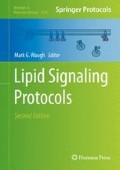Abstract
The fluorescence recovery after photobleaching (FRAP) method is a straightforward means of assessing the diffusional mobility of membrane-associated proteins that is readily performed with current confocal microscopy instrumentation. We describe here the specific application of the FRAP method in characterizing the lateral diffusion of genetically encoded green fluorescence protein (GFP)-tagged plasma membrane receptor proteins. The method is exemplified in an examination of whether the previously observed segregation of the mammalian HER3 receptor protein in discrete plasma membrane microdomains results from its physical interaction with cellular entities that restrict its mobility. Our FRAP measurements of the diffusional mobility of GFP-tagged HER3 reporters expressed in MCF7 cultured breast cancer cells showed that despite the observed segregation of HER3 receptors within plasma membrane microdomains their diffusion on the macroscopic scale is not spatially restricted. Thus, in FRAP analyses of various HER3 reporters a near-complete recovery of fluorescence after photobleaching was observed, indicating that HER3 receptors are not immobilized by long-lived physical interactions with intracellular species. An examination of HER3 proteins with varying intracellular domain sequence truncations also indicated that a proposed formation of oligomeric HER3 networks, mediated by physical interactions involving specific HER3 intracellular domain sequences, either does not occur or does not significantly reduce HER3 mobility on the macroscopic scale.
Access this chapter
Tax calculation will be finalised at checkout
Purchases are for personal use only
References
Krager KJ, Sarkar M, Twait EC, Lill NL, Koland JG (2012) A novel biotinylated lipid raft reporter for electron microscopic imaging of plasma membrane microdomains. J Lipid Res 53:2214–2225
Yang S, Raymond-Stintz MA, Ying W, Zhang J, Lidke DS, Steinberg SL, Williams L, Oliver JM, Wilson BS (2007) Mapping ErbB receptors on breast cancer cell membranes during signal transduction. J Cell Sci 120:2763–2773
Guy PM, Platko JV, Cantley LC, Cerione RA, Carraway KL III (1994) Insect cell-expressed p180erbB3 possesses an impaired tyrosine kinase activity. Proc Natl Acad Sci U S A 91:8132–8136
Kim HH, Vijapurkar U, Hellyer NJ, Bravo D, Koland JG (1998) Signal transduction by epidermal growth factor and heregulin via the kinase-deficient ErbB3 protein. Biochem J 334(Pt 1):189–195
Steinkamp MP, Low-Nam ST, Yang S, Lidke KA, Lidke DS, Wilson BS (2014) erbB3 is an active tyrosine kinase capable of homo- and heterointeractions. Mol Cell Biol 34:965–977
Shi F, Telesco SE, Liu Y, Radhakrishnan R, Lemmon MA (2010) ErbB3/HER3 intracellular domain is competent to bind ATP and catalyze autophosphorylation. Proc Natl Acad Sci U S A 107:7692–7697
Hellyer NJ, Kim MS, Koland JG (2001) Heregulin-dependent activation of phosphoinositide 3-kinase and Akt via the ErbB2/ErbB3 co-receptor. J Biol Chem 276:42153–42161
Choi BK, Fan X, Deng H, Zhang N, An Z (2012) ERBB3 (HER3) is a key sensor in the regulation of ERBB-mediated signaling in both low and high ERBB2 (HER2) expressing cancer cells. Cancer Med 1:28–38
Jura N, Shan Y, Cao X, Shaw DE, Kuriyan J (2009) Structural analysis of the catalytically inactive kinase domain of the human EGF receptor 3. Proc Natl Acad Sci U S A 106:21608–21613
González-González IM, Jaskolski F, Goldberg Y, Ashby MC, Henley JM (2012) Chapter six- measuring membrane protein dynamics in neurons using fluorescence recovery after photobleach. In: Conn PM (ed) Methods enzymology. Academic, New York, pp 127–146
Day CA, Kraft LJ, Kang M, Kenworthy AK (2012) Analysis of protein and lipid dynamics using confocal fluorescence recovery after photobleaching (FRAP). Curr Protoc Cytom/editorial board, J Paul Robinson, managing editor [et al] Chapter 2:Unit2 19
Hellyer NJ, Kim HH, Greaves CH, Sierke SL, Koland JG (1995) Cloning of the rat ErbB3 cDNA and characterization of the recombinant protein. Gene 165:279–284
Soumpasis DM (1983) Theoretical analysis of fluorescence photobleaching recovery experiments. Biophys J 41:95–97
Acknowledgement
The authors wish to acknowledge the University of Iowa Central Microscopy Research Facility for their provision of fluorescence confocal microscopy instrumentation.
Author information
Authors and Affiliations
Editor information
Editors and Affiliations
Rights and permissions
Copyright information
© 2016 Springer Science+Business Media New York
About this protocol
Cite this protocol
Sarkar, M., Koland, J.G. (2016). Fluorescence Recovery After Photobleaching Analysis of the Diffusional Mobility of Plasma Membrane Proteins: HER3 Mobility in Breast Cancer Cell Membranes. In: Waugh, M. (eds) Lipid Signaling Protocols. Methods in Molecular Biology, vol 1376. Humana Press, New York, NY. https://doi.org/10.1007/978-1-4939-3170-5_9
Download citation
DOI: https://doi.org/10.1007/978-1-4939-3170-5_9
Publisher Name: Humana Press, New York, NY
Print ISBN: 978-1-4939-3169-9
Online ISBN: 978-1-4939-3170-5
eBook Packages: Springer Protocols

